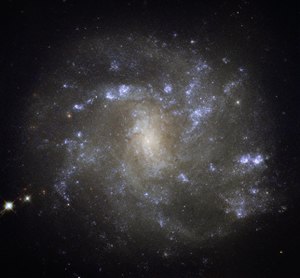NGC 2500
| Galaxy NGC 2500 |
|
|---|---|

|
|
| Photo from the Hubble Space Telescope | |
| AladinLite | |
| Constellation | lynx |
|
Position equinox : J2000.0 , epoch : J2000.0 |
|
| Right ascension | 08 h 01 m 53.2 s |
| declination | + 50 ° 44 ′ 14 ″ |
| Appearance | |
| Morphological type | SB (rs) d / HII |
| Brightness (visual) | 11.5 likes |
| Brightness (B-band) | 12.2 mag |
| Angular expansion | 2.9 ′ × 2.7 ′ |
| Position angle | 48 ° |
| Surface brightness | 13.6 mag / arcmin² |
| Physical data | |
| Redshift | 0.001681 ± 0.000003 |
| Radial velocity | 504 ± 1 km / s |
|
Stroke distance v rad / H 0 |
(24 ± 2) x 10 6 ly (7.41 ± 0.52) Mpc |
| history | |
| discovery | Wilhelm Herschel |
| Discovery date | March 9, 1788 |
| Catalog names | |
| NGC 2500 • UGC 4165 • PGC 22525 • CGCG 262-062 • MCG + 09-13-110 • IRAS 07581 + 5052 • 2MASX J08015322 + 5044135 • GC 1607 • H III 709 • h 478 • KARA 224 • LDCE 558 NED001 | |
NGC 2500 is a spiral dwarf galaxy with extensive star formation regions of the Hubble type SBcd in the constellation Lynx in the northern sky . It is estimated to be 24 million light-years from the Milky Way and about 20,000 light years in diameter.
Together with NGC 2541 , NGC 2537 , NGC 2552 and NGC 2841 , it forms the NGC 2841 galaxy group .
The object was discovered on January 19, 1788 by the astronomer Wilhelm Herschel with a 48 cm telescope.
Web links
Commons : NGC 2500 - collection of images, videos, and audio files
